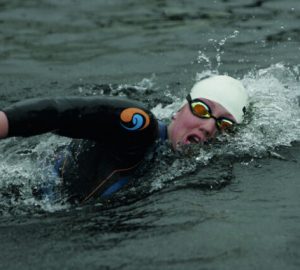How to get into cold water
Previously we’ve recommended the slow approach as this can help reduce the cold shock response, prepare you mentally for the swim and help avoid the panic that cold water can induce. We’ve suggested wading in to waist deep, dangling your hands below the surface and splashing water on your face and neck before submerging the rest of your body. We recommended head up swimming or breaststroke until your breathing stabilizes and your face has adjusted and no longer hurts. If you’re wearing a wetsuit, we’ve also advised letting some water in, climbing back out and then in again.
This approach certainly has its merits but we’ve also identified a problem with it, especially when the water is extremely cold, say below 5 degrees.
At these sorts of temperatures most of us are unlikely to ‘get used to’ the water. Sure there are some that can tolerate it for 30 minutes or more but for newcomers to cold water swimming 30 seconds to a couple of minutes will be plenty.
Water this cold triggers pain sensors in the skin. It hurts rather than feels cold, but the brain does seem to take a few seconds to register that pain. If you wade slowly and then pause this pain will kick in before you start swimming. Waiting does not make it go away (at least, not in our experience) but quickly saps your will-power to venture further into the water.
One way forward is to set an objective, a short distance that you can easily complete. Then, focusing on your objective and without pausing to assess how the water feels, get in quickly, submerge your shoulders and start swimming. Don’t stop until you reach your end point. If you do this fast enough, the pain won’t strike fully until you’ve already started swimming, and by then it may be easier to continue than return. You do need to be mentally prepared though, ready and focused to ensure you don’t panic.
A few, experienced, cold water swimmers dive in. We don’t recommend this until you’re 100% confident in your ability. Cold water shock causes an involuntary gasp reflex. Mental preparation and experience can help reduce this, but it’s really not something you want to happen while you’re under water following a dive.
Cold water triggers a release of adrenalin. Adrenalin junkies seem to like to plunge in quickly whatever the temperature, to maximise the impact. For some of us, especially when the water is exceptionally cold, a quick entry is the only way to overcome our natural urge to avoid pain. When the water is warmer, say 15 degrees or more, and you’re planning to stay in longer, the slower entry may be preferable to reduce cold water shock and the risk of panic.
Which way do you prefer? Let us know.
For more on cold water swimming see Jack Bright’s Extreme Swimming blog






